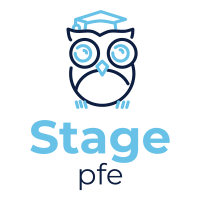
Tarot is increasingly gaining popularity through many people leaning towards its energy to help them make decisions or pursue different activities through providing wisdom and guidance through a higher self-awareness. As tarots continue to gain attention, together with other aspects of astrology and astronomy, people want to explore the world of tarot reading to go through an eye-opening experience.
[bb_toc content=”][/bb_toc]
Tarot Definition & Meaning
Tarot usually refers to a deck of cards people use for fortune telling or as playing cards containing pictures representing different symbols and stories for each individual.
Using a tarot requires an individual with a clear understanding of what they desire before consulting with a tarot reader or any person that knows how to interpret cards and their relationships.
What is a Tarot?
Tarot is a divination method that utilizes a deck of cards to help people obtain clarity and more control over matters affecting opportunity, relationships, and lifestyle choices. The tarot deck dates back more than 500 years. Tarot has developed into a collection of ages-old knowledge thanks to its archetypal foundations, which date back over 2,000 years; interestingly, the tarot is a subset of our current deck of playing cards. There are obscurities when it comes to the history of its symbolism, with tarot cards dating back to the 15th century in Spain, Italy, and France, while some of the tarot symbols have origins that come from China, India, or Egypt.
10 Types of Tarot
Tarot Card Reference
A tarot card reference refers to a guide that contains different and valuable information about each card in the tarot deck, ranging from the Major and Minor Arcana cards. The reference helps individuals to interpret cards they pull from the deck to represent various predictions of their fate regarding different aspects of life, including love, fortune, and career. A tarot card reference is a minimalist outline that people can print on paper or add to a digital device like a phone or tablet for a modern take on traditional paper.
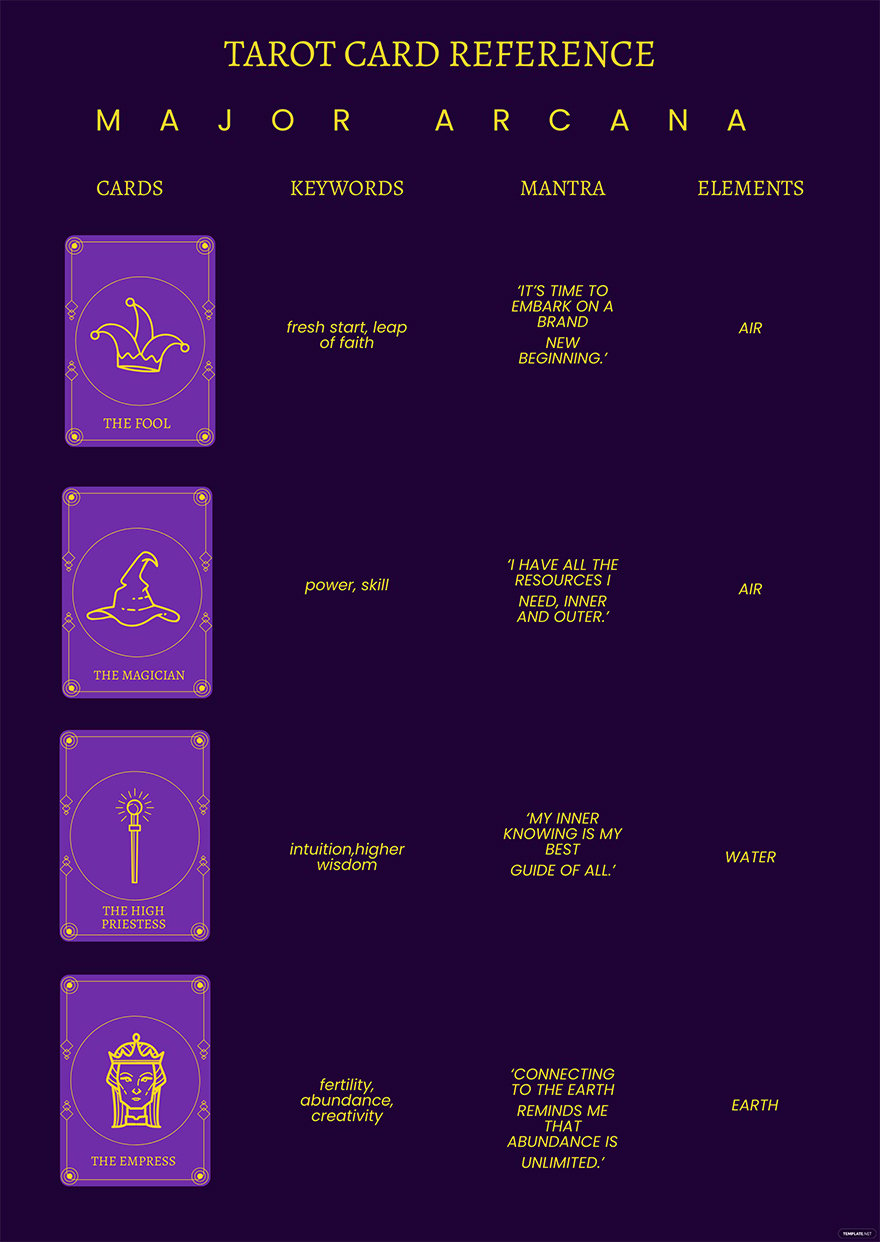
Tarot Reading
Tarot readings help a person acquire the necessary details to understand a particular situation or issue. As readings provide a person with insight into the past, present, and future occurrences based on their current path at the time of the reading, decks are ideal as a tool of spiritual, mystical, and cosmic wisdom and guidance. The cards don’t always predict what will happen; rather, they help a person analyze a situation and choose the most appropriate course of action depending on what is already known and what the cards indicate.

Daily Tarot Journal
Daily tarot journals contain readings that individuals do at the start of their day to align their energies and get psyched with the events for the day, avoiding any unfortunate events in the day. These readings or signs represent a person’s energy, which is why it’s ideal for individuals to keep a clear mind before selecting a card and asking about specific inquiries. Daily tarots are usually composed of a single or triple card, depending on what an individual wants to know about a particular subject or an overall event in general.
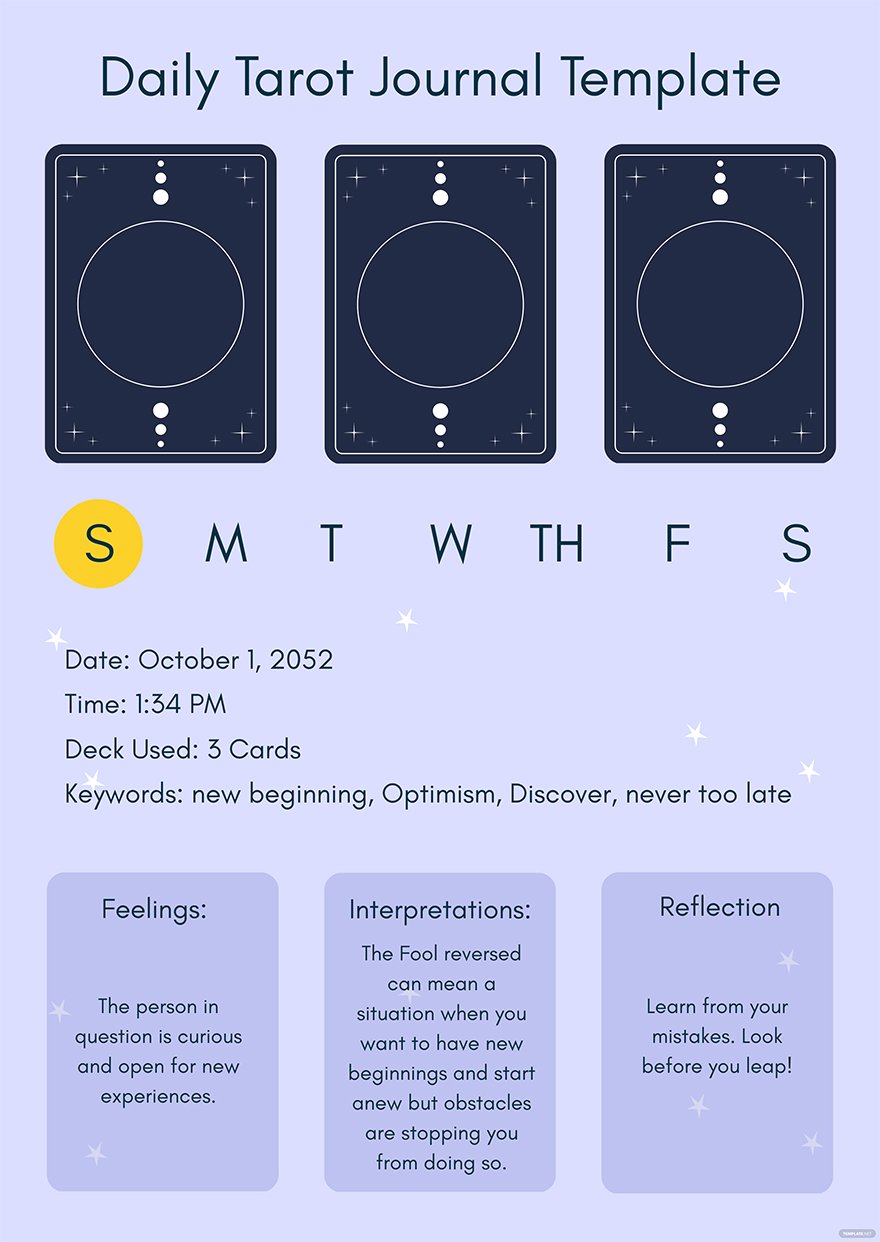
Tarot Cheat Sheet
Tarot cheat sheets consist of a layout or list that provides people with the meaning and description of each tarot card in a deck, including the themes and interpretations of a card. Aside from meanings, cheat sheets also contain information about specific kinds of decks as there are instances that there are varying representations and variations. People can find the upright and reverse meanings for each card beside the name of the cards and their pictures to help people understand and interpret the cards they acquire from readings.

Tarot Monthly Card Tracker
A tarot monthly card tracker shows how many times a specific card showed up during daily tarot readings, helping individuals to keep track of their energies and control monthly. People use the monthly tracker to check how many times a card appears on their readings, with monthly tarots incorporating cards from both major and minor arcana. The tracker serves as a roadmap for an individual to identify goals, problems, and accomplishments throughout a month and the influences of the tarots in their activities.
![]()
Tarot Meanings Guide
A tarot meanings guide is a helpful instrument for individuals starting to explore the beautiful and deep world of tarot reading and interpretation. The guide is an educational component that people can access either on an app or through an online source like a website to help them review and interpret cards appearing for their readings. It contains information about the upright and reversal meaning of cards and what the card looks like, together with its name.
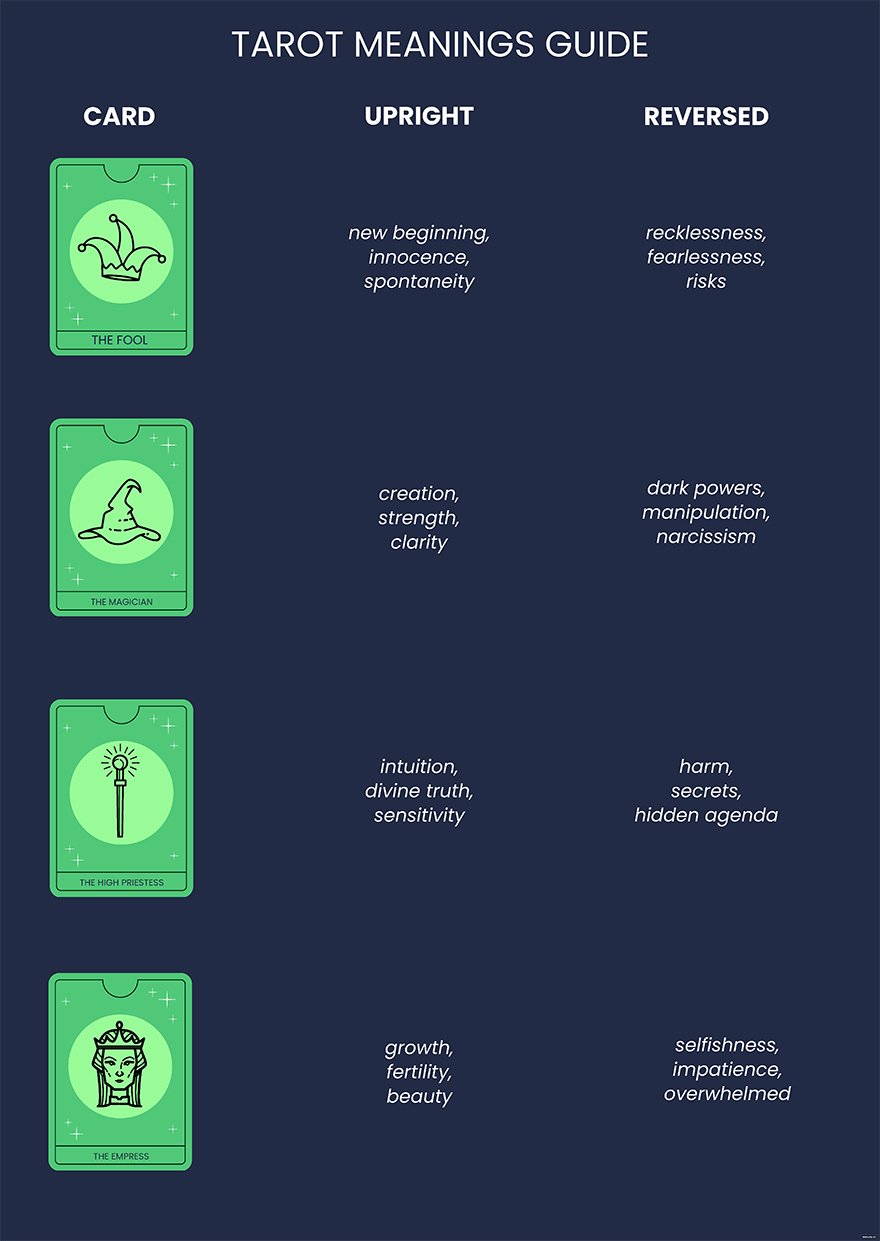
Tarot Journal
A tarot journal is essentially a notebook where individuals can keep track of their progress with tarot, learn about the various cards, and record a person’s ideas, feelings, various spreads, and unique readings of the cards. Each person’s tarot diary is unique and original since it is a very private project that enables the individual to talk openly about their relationship with the tarot. As long as you are getting the most out of the process, there is no proper or incorrect way for the diary to appear.
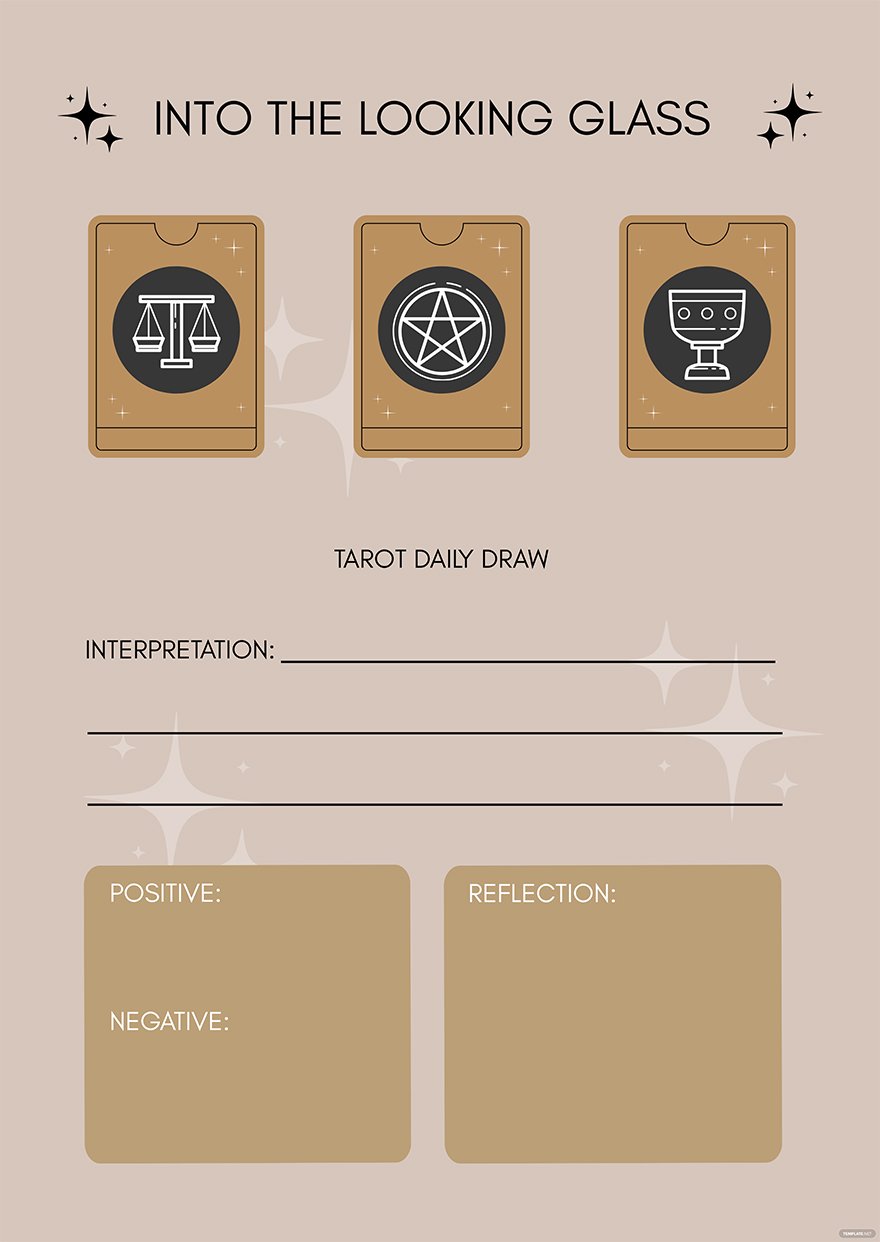
Tarot Spreads
The patterns of cards drawn from a deck throughout a reading are referred to as tarot spreads in tarot readings, with tarot readers using diverse techniques to ground the individual seeking advice before card placements. People use spreads as though they are attempting to get insight into a situation or are making a decision and are feeling overwhelmed. A tarot spread is a planned arrangement of cards in which each placement stands for an answer to a query.

Tarot Uses, Purpose, Importance
Tarot cards are valuable tools individuals use to guide different aspects and sections of a person’s life and orbit, including love, career, money, and goals. As such, tarots are introspective instruments that enable people to look inwards, examining their thoughts, feelings, emotions, judgments, and beliefs, taking a closer look at their inner life. There are various uses for tarots, and each one provides different objectives and purposes, all to tap into their intuition to find guidance and problem-solving regarding multiple questions in life.
Meditation
One of the many uses of tarot is meditation, supplying the body with several benefits to reduce stress and anxiety while increasing attention span and enhancing memory capabilities. Tarots can aid individuals in their meditation practices by selecting the desired tarot card from a deck, taking glimpses, or focusing on it during the meditation process. People picture and focus on the card and the image it represents, reflecting on their symbol, the emotion they produce, and how it can guide the person’s intentions for the entire day.
Prompts
People can also use tarot as prompts for different activities, including writing, drawing, scrapbooking, and other forms of art and expression that require individuals to spark inspiration. Treat tarot cards like how any person treats a prompt or a muse to create something beautiful, expressive, meaningful, or anything relating to the feeling or emotion an individual wants to show in their work. Select a tarot card from a deck and look at the name, illustration, and meaning before developing an art, story, or image without worrying about being literal or abstract.
Story Writing
Another use that individuals can take from tarot cards is to inspire them to build characters and personas, story plot and structure, along with other parts of a fictional story. When a writer feels an incoming writer’s block, they can pull out a tarot card deck to help them approach stories and plots from a different perspective. Start by shuffling tarot cards, focusing on the problem they are trying to solve, whether it is developing character dynamics, helping characters navigate through the story, or developing ideas for the next chapter.
Manifesting and Visualizing Desires
Visualization is one of the many factors that can contribute to success and increase performance, and visualizing oneself toward something and achieving them helps to manifest an event or an idea. To do this, an individual selects a tarot from the deck that closely aligns with the goals they want to achieve in different aspects of their life. For example, the Sun card symbolizes happiness, contentment, and success for those wishing to achieve something, and the Magician represents willpower, design, and creation, especially for those wanting to start new projects.
Decision Making
Shuffle tarot cards while thinking about the decisions and options individuals can select from, relying solely on an individual’s intuition in interpreting the decision that is right for them. When drawing or selecting a tarot card, it gives people a sense of hope that makes them want to land or acquire a specific tarot card to arrive at a decision, and it is the way the subconscious mind gives answers to the conscious self. The cards are a tool for tapping into the inner wisdom, with the tarot providing an individual something that focuses their attention towards something they want to obtain.
What’s in a Tarot? Parts?
Major Arcana
A tarot contains two primary groups, with one of them being the Major Arcana, consisting of 22 cards, starting with the Fool, the Magician, the High Priestess, the Empress, the Emperor, the Hierophant, the Lovers, the Chariot, Strength, the Hermit, Wheel of Fortune, Justice, the Hanged Man, Death, Temperance, the Devil, the Tower, the Star, the Moon, the Sun, Judgment, and the World.
Minor Arcana
The Minor Arcana cards represent the remaining 56 cards of a tarot containing the smaller mysteries or secrets that consists of four suits, including the suit of cups, wands, swords, and pentacles, with each suit containing one through ten and the court cards of King, Queen, Knight, and Page.
How to Design a Tarot Template?
1. Determine the Tarot Size
2. Specify the Purpose of Creating the Tarot
3. Select from the Tarot Templates
4. Begin with a Concept Design and Art Style
5. Do Homework and Research About Spreads and Archetypes
6. Do a Test Run for the Card Deck
7. Revise the Tarot as Necessary
8. Study the Target Market
Tarot Vs. Astrology
Tarot readings are more specific to an individual, with the cards coming from the reader’s spiritual guide, drawn at random, with the message being minor or urgent.
Astrology, on the other hand, focuses on math and the positions of the sun, moon, and planets as it focuses on the study of the positions of celestial bodies.
What’s the Difference Between Tarot, Zodiac, and Horoscope?
Tarot refers to a deck of cards, holding a total of 78 cards containing distinct symbols, imageries, and stories to represent feelings or emotions for fortune telling, originating in the 1430s.
Zodiac is an area in astronomy that refers to a region in the sky where the sun, moon, and planets present themselves, containing twelve divisions or constellations.
Horoscope, on the other hand, is an area in astrology that focuses on the interpretations of astrologers according to the heavenly systems, including the sun, moon, planets, and the zodiac signs.
Tarot Sizes
There are different sizes for tarots, depending on how a person plans to use them for their readings or spiritual guidance toward various activities in their life. There are diverse elements for people wanting to be adept in tarots, including cards, journals, and cheat sheets, with tarot sizes corresponding to each one.
- Regular card (2.75 x 4.75 inches)
- Journal (8.3 x 11.7 inches)
- Cheat sheet (8.5 x 11 inches)
Tarot Ideas & Examples
Different tarot ideas for design determine the energy and intention that a person creates for their tarot card decks, with beautiful art styles and illustrations representing how they see each card. When crafting a new deck of tarot cards, especially personal cards, the individual must be able to express each card according to its intentions.
- Tarot Ideas and Examples
FAQs
What does a tarot contain?
Tarots contain picture cards that represent principles, concepts, and ideas, using various card sets and suits.
What is the rarest tarot card?
The rarest tarot card deck in existence is the Visconti-Sforza, considered one of the oldest and most vintage card decks in the world.
Is tarot a language symbol?
Tarot is a language of symbols for many individuals who use them, representing divination, card readings, and the occult.
Are tarot cards part of astrology?
Since tarots represent symbols, it has connections with various facets, including deep roots in astrology.
What is a tarot journal?
A tarot journal is a notebook that tracks the tarot progress of an individual, understanding the various cards they draw for each day.
What season do the wands represent in tarot?
The wands deck of a tarot represents the season of spring or the spring court.
What elements do the cards represent?
There are four elements that tarot cards represent, including fire, water, earth, and air, corresponding to the suit of wands, cups, pentacles, and swords, respectively.
What is the right way to shuffle the tarot cards?
Shuffling the tarot cards has something to do with clearing or cleansing the energy of previous card formations and individuals shuffle the card by using the non-dominant hand for intuitive and receptive energy.
What culture does tarot come from?
Tarot cards most likely originated in Italy, specifically in Northern Italy, during the 14th to 15th century.
When did tarot cards become popular?
It was during the 1900s when tarot started gaining popularity in the United States.
